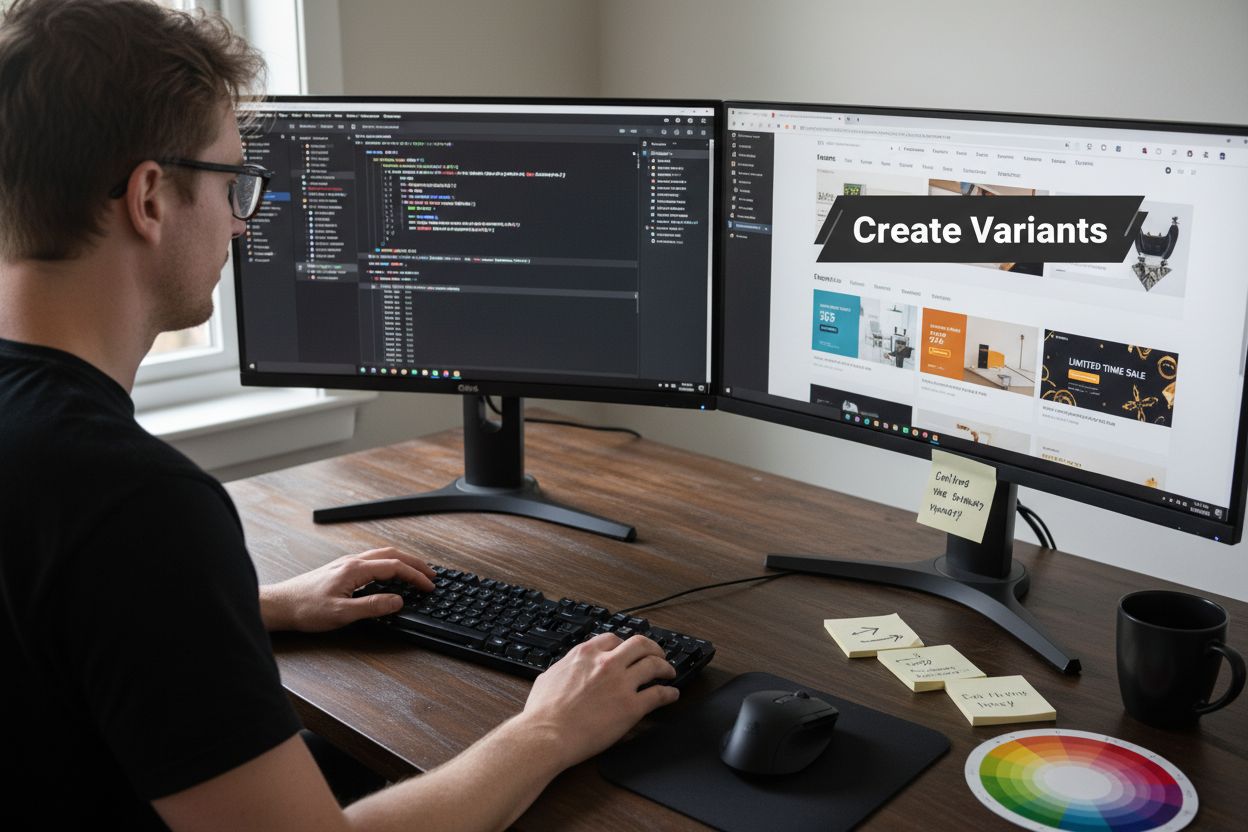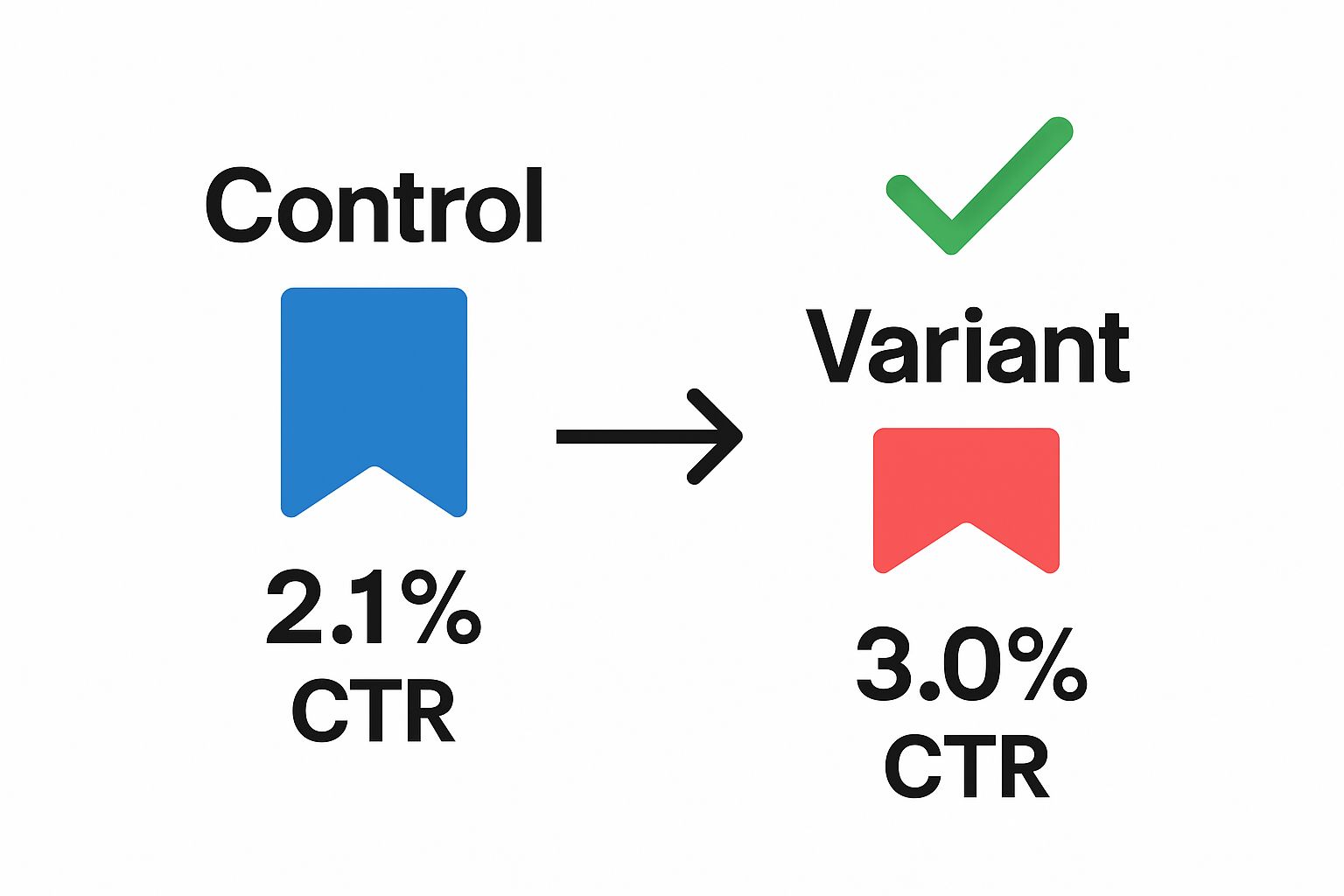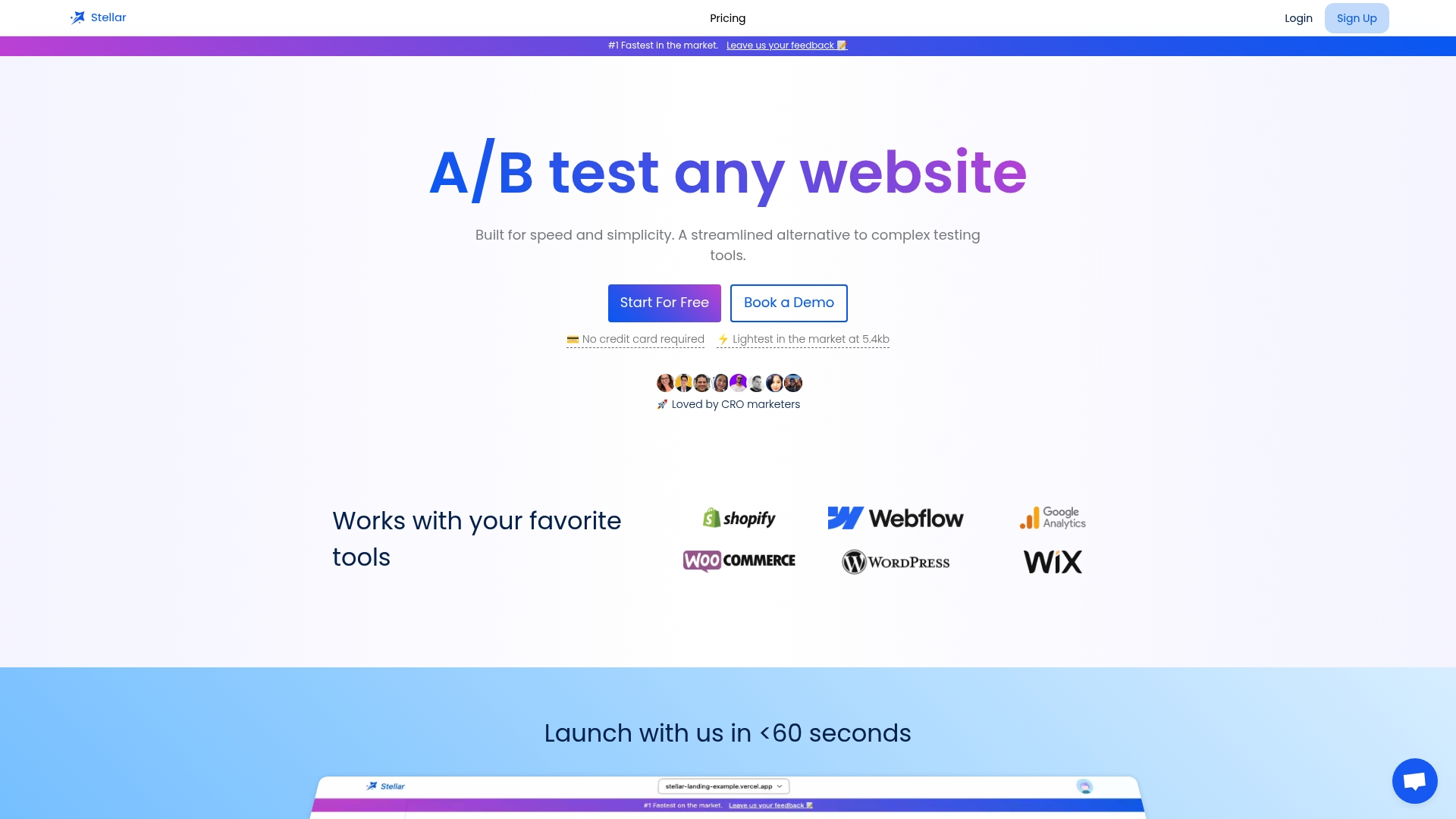
Master Testing Website Banners for Optimal Conversions

Testing website banners usually sounds like a minor tweak. Yet, a single well tested banner can lift click through rates by 15% or more in just 90 days. Most people think banner testing is just about swapping colors or slogans but the real edge comes from a scientific process where every experiment can teach you how users truly behave. The biggest breakthroughs hide in the small details.
Table of Contents
- Step 1: Define Clear Objectives For Your Banner Test
- Step 2: Select Your Testing Tools And Setup Environment
- Step 3: Create Variants Of Your Website Banners
- Step 4: Implement A/B Testing On Your Website
- Step 5: Analyze Results And Optimize Based On Data
- Step 6: Verify Improvements And Prepare For Future Tests
Quick Summary
| Key Point | Explanation |
|---|---|
| 1. Set Clear Conversion Goals | Define specific, measurable goals for your banner tests to ensure focused and effective improvements. |
| 2. Choose Appropriate Testing Tools | Select testing platforms that integrate easily with your site and provide robust statistical analysis capabilities. |
| 3. Design Meaningful Banner Variants | Create distinct banner designs that test different hypotheses to gather actionable insights on user behavior. |
| 4. Implement Effective A/B Testing | Randomly divide traffic between variations and ensure sufficient sample sizes for statistically significant results. |
| 5. Analyze Results Holistically | Go beyond click-through rates to evaluate overall user engagement and ensure improvements are meaningful and sustainable. |
Step 1: Define Clear Objectives for Your Banner Test
Successful testing website banners begins with crystalline clarity about your conversion goals. Without precise objectives, your testing efforts become scattered and ineffective. Your initial task involves articulating exactly what you want to achieve through your banner experiment.
Start by identifying the specific metric you want to improve. Conversion rate improvement is typically the primary goal, but this could mean different things for different organizations. Are you seeking to increase click through rates, reduce bounce rates, drive more email sign ups, or generate more product purchases? Each objective demands a nuanced testing approach.
Consider your current website performance baseline before designing any test. Pull your existing analytics data to understand current banner performance. What is your existing click through rate? What percentage of visitors currently interact with your banners? These baseline metrics will help you establish meaningful benchmarks against which you can measure future improvements.
Your objectives should follow SMART criteria: Specific, Measurable, Achievable, Relevant, and Time bound. Instead of a vague goal like "improve banner performance," craft a precise target such as "Increase banner click through rate by 15% within the next 90 days by testing two distinct design variations."
While defining objectives, also anticipate potential challenges. Recognize that not every test will yield dramatic improvements. Some experiments might reveal minimal gains or even temporary performance dips. Realistic expectations are crucial. Commit to a systematic approach where each test provides actionable insights, regardless of whether it dramatically boosts conversions.
Lastly, align your banner testing objectives with broader marketing and business goals. Your banner tests should interconnect with overall strategic priorities. Learn more about optimizing conversion strategies to ensure your tactical experiments contribute meaningfully to larger organizational objectives.
Step 2: Select Your Testing Tools and Setup Environment
Choosing the right testing tools for website banners is critical to gathering accurate, actionable insights. Your testing environment will determine the quality and reliability of your conversion optimization efforts. Not all tools are created equal, and selecting a platform that matches your specific needs requires careful consideration.
Performance and lightweight implementation should be your primary considerations when evaluating testing platforms. Look for tools that integrate seamlessly with your existing website infrastructure without significantly impacting page load times. Some platforms require extensive JavaScript installations that can slow down your site, potentially undermining the very conversions you aim to improve.
When evaluating testing tools, prioritize platforms offering robust statistical analysis capabilities. You want a solution that can quickly determine statistical significance, handle sample size calculations, and provide clear visualization of test results. Real time reporting becomes essential for making swift, data driven decisions. Seek out tools that offer comprehensive dashboards showing conversion rates, confidence intervals, and potential revenue impacts.
Explore fast and efficient testing solutions that minimize performance overhead while maximizing insight generation. Your ideal testing environment should support multiple banner variations, enable precise traffic segmentation, and provide granular tracking of user interactions.
Technical setup requires meticulous attention. Ensure your chosen platform can integrate with your current analytics systems. Install tracking scripts carefully, verifying they do not interfere with existing website functionality. Run preliminary compatibility tests to confirm the testing tool works harmoniously with your content management system and does not introduce unexpected rendering issues.
Budget considerations matter, but avoid selecting a tool solely based on price. Free or low cost solutions might seem attractive, but they often lack the sophisticated features needed for comprehensive banner testing. Invest in a platform that provides depth of analysis, reliable data collection, and responsive customer support. Your testing tool is not an expense but a strategic investment in understanding and improving user engagement.
Step 3: Create Variants of Your Website Banners
Designing compelling banner variants requires strategic thinking and a systematic approach to testing website banners. Your objective is to create meaningful variations that will provide actionable insights into user preferences and behavior. Each variant should represent a distinct hypothesis about what might improve user engagement and conversion rates.
Meaningful variation is key. Avoid making superficial changes that do not significantly impact user perception. Instead, focus on creating substantive differences in design elements that could influence user decision making. Consider exploring variations in color schemes, messaging, imagery, layout, and call to action positioning. One banner might use a bold, direct approach while another employs a more subtle, emotional narrative.
When crafting your variants, establish a clear control version representing your current banner design. This baseline will serve as the benchmark against which all experimental variations are measured. Typically, you want to create two to four alternative designs that systematically test different hypotheses. For instance, one variant might emphasize product benefits, while another focuses on solving specific user pain points.
Learn about strategic variant selection to ensure your experiments provide meaningful insights. Technical precision matters as much as creative design. Ensure each variant maintains consistent brand messaging and visual alignment, with only strategic differences that can be analytically traced.
Pay close attention to psychological triggers that might influence user behavior. Color psychology plays a significant role in perception. Blue might communicate trust and professionalism, while red could evoke urgency or excitement. Typography and font choices also subtly communicate brand personality. A serif font might suggest tradition and reliability, whereas a sans serif design could indicate modernity and simplicity.
Before launching your test, conduct an internal review to validate that each banner variant is technically sound and aligns with your broader marketing objectives. Confirm that variations are distinct enough to generate meaningful data but not so divergent that they compromise brand consistency. Your goal is to create a scientifically structured experiment that provides clear, actionable insights into user preferences and conversion optimization strategies.

Step 4: Implement A/B Testing on Your Website
Implementing A/B testing for website banners requires precision, patience, and a methodical approach. Your goal is to systematically expose different banner variants to segments of your website traffic and collect robust performance data. This step transforms your strategic planning into actionable insights about user preferences and conversion potential.
Traffic allocation matters significantly. Divide your website visitors randomly and equally between your control banner and experimental variants. Most testing platforms offer automatic traffic segmentation, but verify the distribution manually to ensure statistical integrity. Aim for a sample size large enough to generate meaningful results while maintaining statistical significance. Typically, this means running tests until you have collected at least 1000 visitor interactions for each banner variant.
Configuring your testing environment requires careful attention to technical details. Implement tracking mechanisms that capture comprehensive user interaction data. Beyond simple click through rates, track metrics like time spent viewing the banner, mouse hover duration, and subsequent conversion actions. Granular data collection provides deeper insights into user behavior beyond surface level metrics.
Understand the nuances of effective A/B testing to maximize your experimental design. Minimize external variables that could skew your results. Run tests during consistent time periods to avoid potential seasonal or day of week variations. Ensure your testing platform prevents users from seeing multiple banner versions, which could introduce cognitive confusion and compromise data reliability.
Set clear test duration parameters before launching your experiment. While it is tempting to draw quick conclusions, most statistical experts recommend running tests for at least two complete business cycles.
This approach accounts for potential variations in user behavior across different days and times. Premature termination of tests can lead to misleading or statistically insignificant conclusions.
Monitor your test continuously but resist the urge to make frequent adjustments. Statistical validity requires allowing the experiment to run its complete course. Your disciplined approach to data collection and analysis will ultimately determine the quality of insights generated from your website banner testing efforts.
Here is a step overview table summarizing each main step of the banner testing process, including its focus and key outcome.
| Step | Focus | Key Outcome |
|---|---|---|
| 1. Define Objectives | Set precise, SMART goals | Clear measurement targets for meaningful testing |
| 2. Select Tools & Setup | Choose and configure testing tools | Reliable environment for accurate data collection |
| 3. Create Variants | Design distinct banner options | Meaningful alternatives to test hypotheses |
| 4. Implement A/B Test | Deploy and manage experiments | Statistically valid user data from traffic split |
| 5. Analyze Results | Review metrics and significance | Actionable insights for optimization |
| 6. Verify & Prepare | Confirm improvements, plan next tests | Sustained performance and a roadmap for future tests |
Step 5: Analyze Results and Optimize Based on Data
Analyzing A/B testing results transforms raw data into strategic insights that drive meaningful website banner improvements. This critical step requires a systematic approach to interpreting performance metrics, understanding statistical significance, and translating findings into actionable optimization strategies.
Statistical significance is your north star when evaluating test results. Not all variations represent genuine user preference shifts. Look beyond surface level metrics to understand the depth and reliability of your findings. A statistically significant result typically requires a confidence level of 95% or higher, meaning you can be 95% certain that the observed differences are not due to random chance.

Carefully examine multiple performance indicators beyond simple click through rates. Analyze metrics like conversion rate, engagement duration, bounce rate, and user interaction patterns. Holistic data interpretation provides a more comprehensive understanding of how different banner variants influence user behavior. One variant might generate more clicks, while another could drive higher quality conversions or longer site engagement.
Discover advanced methods for interpreting test data to elevate your conversion optimization strategies. Pay close attention to audience segment variations. The banner that performs best for one user demographic might underperform for another. Break down results by factors like age, device type, geographic location, and traffic source to uncover nuanced insights.
When a clear winner emerges, resist the temptation to immediately implement the top performing variant across your entire website. Instead, plan a gradual rollout that allows continued monitoring and refinement. Create a systematic implementation strategy that involves incremental deployment, ongoing performance tracking, and maintaining flexibility for future iterations.
Documentation becomes crucial in this phase. Record not just the numerical results, but the qualitative observations and hypotheses that emerged during testing. This documentation serves as an invaluable knowledge base for future optimization efforts, helping your team build a deeper understanding of user preferences and behavior patterns over time. Your meticulous approach to data analysis transforms A/B testing from a tactical exercise into a strategic mechanism for continuous website improvement.
Step 6: Verify Improvements and Prepare for Future Tests
Verifying the effectiveness of your banner testing results requires a comprehensive and disciplined approach that goes beyond initial data interpretation. This final step transforms your experimental insights into sustainable conversion optimization strategies, ensuring that improvements are genuine and replicable across your digital ecosystem.
Validation is more than statistical confirmation. Implement a comprehensive verification process that cross references your A/B testing results with broader website performance metrics. Examine how the winning banner variant impacts overall user experience, conversion funnels, and long term engagement rates. A banner that improves immediate click through rates might not necessarily translate to improved downstream conversion metrics.
Conduct a thorough performance review by comparing key performance indicators before and after implementation. Look beyond surface level metrics to understand the holistic impact of your banner changes. Granular performance tracking helps distinguish between temporary fluctuations and meaningful, sustained improvements. Monitor metrics like bounce rate, average session duration, and conversion rate to ensure your optimized banner genuinely enhances user experience.
Learn about maintaining testing performance standards to continually refine your optimization approach. Develop a systematic framework for ongoing experimentation. Each completed test should generate hypotheses for future iterations. Create a testing roadmap that prioritizes potential variations based on their likely impact and alignment with broader business objectives.
Prepare a comprehensive test documentation package that captures not just numerical results, but the strategic reasoning behind each experimental variant. This knowledge repository becomes invaluable for training team members, establishing institutional learning, and creating a culture of data driven optimization. Include detailed notes about hypothesis formulation, design rationale, and unexpected insights discovered during the testing process.
Remember that conversion optimization is an iterative journey. No single test represents a permanent solution, but rather a stepping stone toward continuous improvement. Maintain intellectual humility and curiosity. Each test provides an opportunity to deepen your understanding of user behavior, refine your experimental approaches, and incrementally enhance your website's performance.
Below is a troubleshooting table highlighting common banner testing challenges, their likely causes, and recommended solutions as mentioned in the article.
| Problem | Likely Cause | Recommended Solution |
|---|---|---|
| Slow website performance | Heavy or poorly integrated testing tools | Use lightweight solutions and check technical compatibility |
| Confusing or inconclusive data | Superficial banner changes or poor test setup | Make meaningful variant changes and run tests for full cycles |
| Poor statistical significance | Insufficient traffic or sample size | Target at least 1,000 interactions per variant, extend test duration |
| Temporary performance dips | Natural user variability or small improvements | Set realistic expectations, focus on long-term trends |
| Misleading improvements | Focusing only on CTR, not holistic metrics | Analyze conversion, engagement, and bounce rate after rollout |
Frustrated by Complicated and Slow Banner Testing?
Optimizing your website banners can feel overwhelming when faced with clunky tools, slow site speeds, and indecisive test results. If you want to increase click-through rates, improve conversions, and operate with genuine data clarity, you deserve a faster, simpler solution. As highlighted in "Master Testing Website Banners for Optimal Conversions," effective A/B tests mean having real-time analytics, lightweight integrations, and user-friendly workflows. Many marketers struggle with:
- Banner tests that slow down their website
- Confusing data that lacks actionable insights
- Technical bottlenecks during setup and analysis

Take control now. Stellar is purpose-built for marketers and growth hackers who want robust A/B testing without technical headaches. Whether you are creating new banner variants or trying to ensure statistical significance, our no-code visual editor and advanced goal tracking empower you to launch tests and use real-time data without any coding. Experience the fastest testing tool on the market with a script size of just 5.4KB and see why so many small and medium businesses have upgraded to Stellar! Ready to stop guessing and start optimizing? See how it works and launch your first frictionless test today.
Frequently Asked Questions
How do I define clear objectives for testing website banners?
Start by identifying your specific conversion goals, such as improving the click-through rate or increasing email sign-ups. Ensure these objectives follow SMART criteria—make them Specific, Measurable, Achievable, Relevant, and Time-bound.
What metrics should I use to evaluate the performance of my banner tests?
Focus on key metrics such as conversion rates, click-through rates, and engagement duration. Collect baseline data before testing, and track the performance of each variant against these metrics to determine what drives better user interaction.
How do I ensure that my banner variations are meaningful?
Create variants based on distinct hypotheses about user behavior, such as testing different color schemes or messaging styles. Too many superficial changes can dilute the effectiveness of your tests; aim for 2 to 4 well-defined versions to analyze.
What steps should I take when implementing A/B testing for website banners?
Randomly divide your website traffic between your control banner and the variants to ensure statistical integrity. Set a sample size of at least 1,000 interactions for each variant to gather meaningful data and maintain consistency throughout the test duration.
How can I analyze the results of my banner tests effectively?
Evaluate data for statistical significance, looking for a confidence level of 95% or higher. Review multiple indicators, such as bounce rates and user engagement metrics, to gain a comprehensive understanding of how different banners perform.
What should I do after analyzing results to verify improvements?
Cross-reference the results with broader website performance metrics to ensure sustained improvements. Develop a thorough documentation process detailing hypotheses and outcomes to inform future testing strategies.
Recommended
Published: 10/12/2025